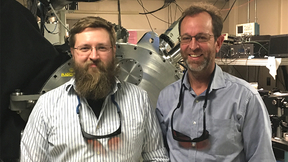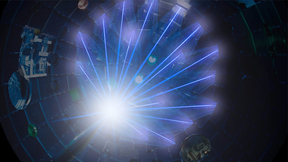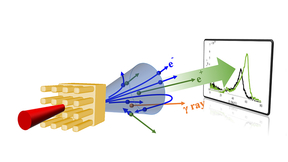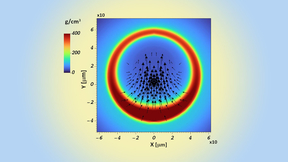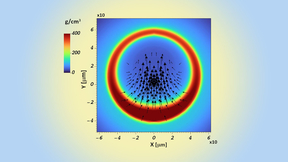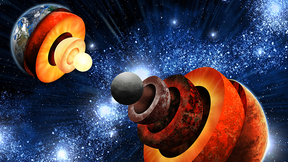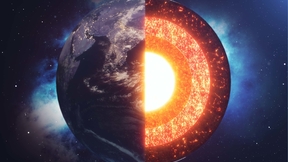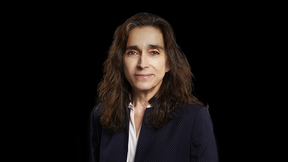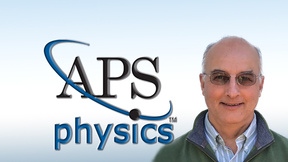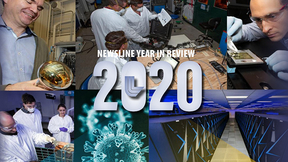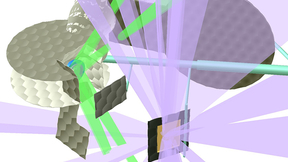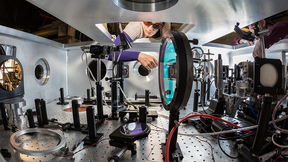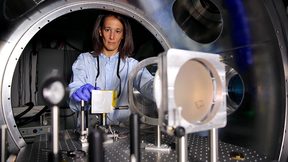Back
For the first time, researchers have isolated in a controlled laboratory setting the effects of the plasma geometry in its X-ray emission spectrum – the energy distribution of the radiation the plasmas emit. The work also is the first experimental testbed of the theories describing a phenomenon known in astrophysics as resonant scattering. This phenomenon is found in a…
Lawrence Livermore National Laboratory (LLNL) scientists recently published the results of a three-week experimental campaign at the Lab’s Jupiter Laser Facility to test the performance of laser-heated additive manufactured foams. The project helps support two major Laboratory focus areas, including helping to advance additive manufacturing and by enabling improvements in…
Lawrence Livermore National Laboratory (LLNL) scientists recently published the results of a three-week experimental campaign at the Lab’s Jupiter Laser Facility to test the performance of laser-heated additive manufactured foams. The project helps support two major Laboratory focus areas, including helping to advance additive manufacturing and by enabling improvements in…
An influential Department of Energy (DOE) advisory committee has recommended that the nation move aggressively toward the deployment of fusion energy, including investments in technology and equipment to support one of the core missions of LLNL’s National Ignition Facility (NIF) — laying the groundwork for the development of inertial fusion energy (IFE). The report,…
Lawrence Livermore National Laboratory (LLNL) scientists have achieved a near 100 percent increase in the amount of antimatter created in the laboratory. Using targets with micro-structures on the laser interface, the team shot a high-intensity laser through them and saw a 100 percent increase in the amount of antimatter (also known as positrons). The research appears in…
Inertial confinement fusion (ICF) implosions require very high levels of symmetry in order to reach the high densities and temperatures required for fusion induced self-heating. Even percent-level deviations from perfect spherical symmetry can lead to significant distortions of the implosion and ultimately degrade fusion performance. To that end, researchers from Lawrence…
Inertial confinement fusion (ICF) implosions require very high levels of symmetry in order to reach the high densities and temperatures required for fusion induced self-heating. Even percent-level deviations from perfect spherical symmetry can lead to significant distortions of the implosion and ultimately degrade fusion performance. To that end, researchers from Lawrence…
Nearly a year into piloting a major scientific institution through one of the most taxing and disruptive global events in modern history, outgoing Livermore Lab Director Bill Goldstein is ready for a vacation. One of Goldstein’s first orders of business following his retirement on March 1 is returning to the lush slopes, coffee plantations and sandy beaches of Kona, Hawaii…
Advances in astronomical observations have resulted in the discovery of an extraordinary number of extrasolar planets, some of which are believed to have a rocky composition similar to Earth. Learning more about their interior structure could provide important clues about their potential habitability. Led by Lawrence Livermore National Laboratory (LLNL), a team of…
In an effort to better understand how materials deform under extreme conditions, researchers at Lawrence Livermore National Laboratory (LLNL) have developed a new experimental method for probing large-strain and high-rate material strength. In a paper recently published in Acta Materialia, Jonathan Lind, LLNL physicist and lead author, said results of the work aid in…
Temperature is tough to measure, especially in shock compression experiments. A big challenge is having to account for thermal transport — the flow of energy in the form of heat. To better understand this challenge, researchers from Lawrence Livermore National Laboratory (LLNL) have taken important steps to show that thermal conduction is important and measurable at high…
Kim Budil has been named director of Lawrence Livermore National Laboratory (LLNL). Charlene Zettel, chair of Lawrence Livermore National Security, LLC (LLNS), which manages the Laboratory for the Department of Energy's (DOE) National Nuclear Security Administration (NNSA), made the announcement to Laboratory employees Jan. 28. Budil will begin her new role on March 2…
Carbon is one of the most ubiquitous elements in existence. As the fourth most abundant element in the universe, a building block for all known life and a material that sits in the interior of carbon-rich exoplanets, the element has been subject to intense investigation by scientists. Decades of studies have shown that carbon’s crystal structure has a significant impact on…
The first-ever shot to study a high explosive sample was recently conducted at the National Ignition Facility (NIF), the world’s most energetic laser. The results from the shot included novel data that will help researchers unlock the mysteries of high-explosive (HE) chemistry and position Lawrence Livermore National Laboratory (LLNL) to continue its legacy as a leader in…
As an experimentalist at Lawrence Livermore National Laboratory (LLNL) developing diagnostics and experimental techniques in the field of dynamic high-pressure physics, Peter Celliers is on the path of leading a national topical group of the American Physical Society (APS). Celliers was recently elected to the executive committee as vice-chair of the American Physical…
Though 2020 was dominated by events surrounding the COVID-19 pandemic — whether it was adapting to social distancing and the need to telecommute, safeguarding employees as they returned to conduct mission-essential work or engaging in COVID-related research — Lawrence Livermore National Laboratory (LLNL) managed an exceptional year in all facets of science and technology…
Lawrence Livermore National Laboratory (LLNL) researchers have developed an X-ray source that can diagnose temperature in experiments that probe conditions like those at the very center of planets. The new source will be used to perform extended X-ray absorption fine structure (EXAFS) experiments at the National Ignition Facility (NIF). The work was published in Applied…
Alexus “Lexi” Warchock was initially disappointed when she learned the NIF & Photon Science Summer Scholar Program would be continuing — but as a virtual internship. “I was upset knowing I would miss out on seeing firsthand the amazing (Lab) facility and interacting with other Lab employees,” the University of Michigan-Dearborn senior said. “My dream of moving out from…
LaserNetUS, a network of facilities operating ultra-powerful lasers including those at Lawrence Livermore National Laboratory (LLNL), has received $18 million from the Department of Energy (DOE) for user support. Established in 2018 by DOE, LaserNetUS is organized and funded by DOE’s Office of Fusion Energy Sciences (FES). The new network was created to provide vastly…
Félicie Albert, staff scientist at Lawrence Livermore National Laboratory's (LLNL) NIF & Photon Science and the Joint High Energy Density Sciences organization, has been elected a Kavli Fellow of the U.S. National Academy of Sciences (NAS). As a new Kavli Fellow, Albert was invited to present a poster about next-generation X-ray light sources during NAS’ annual Kavli…



